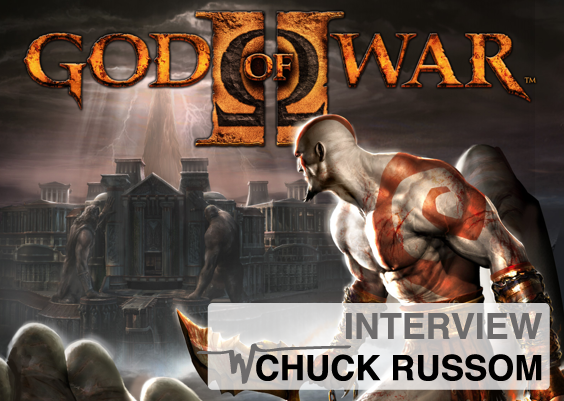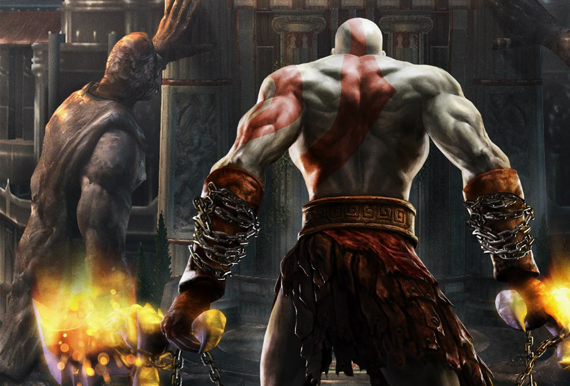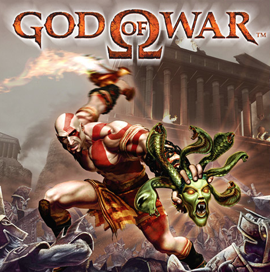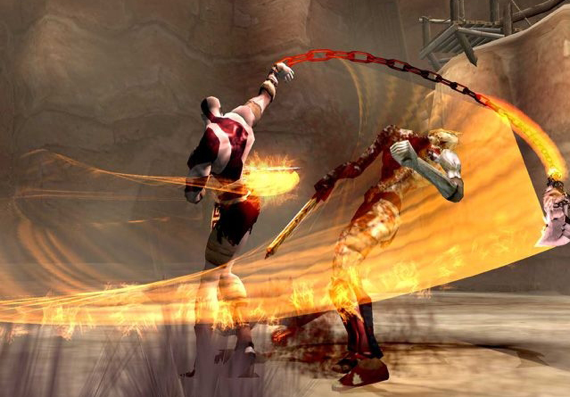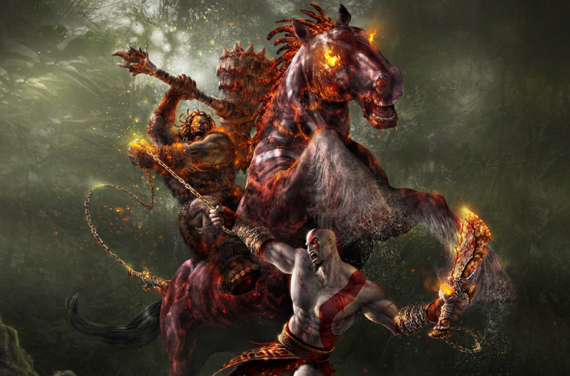Continuing with the special of Chuck Russom, here’s a very cool talk I had with him, about the sound design of “God of War I” and “God of War II”. Check:
Designing Sound: How early you came into the development of “God of War I” and “God of War II”?
Chuck Russom: It’s funny talking about GOW1 and GOW2 now, since GOW3 was just released! We’ll have to see how good my memory is, since we are talking about a period of time between 2004 and 2007, and with the amount of work and number of hours that went into those games, it’s all a blur!
Before GOW1 was even finished, I was hired to be the Audio Lead for GOW2 (or what ever followup game the team would make). When I started working at Sony in October 2004, GOW1 was just hitting Alpha and was about 4-5 months away from shipping.
Much of the design and gameplay on GOW1 came on very late in the development cycle. I joined the audio team as an additional sound designer, to help get the audio finished.
Pre-production on GOW2 started just after the first title shipped. I was on GOW2 from day 1, though I had other projects I was also working on. During the early days of God of War II, I spent very little time actually working on the title (due to my commitments to other Sony projects). Mostly I would keep track of what was happening during pre-production and attend meetings with the dev team.
I began to devote all of my time to GOW2 in September or October of 2005. The game shipped in March 2007.
DS: What is the importance the rest of developers give to the sound of GoW series? How was your relationship with both of them?
CR: On both titles, the development team assigned sound impmenters to work with the audio team. The implementers were the main liason between the audio team and the development team. They were responsible for getting all of our sounds implemented in the game engine. Their tasks included setting up ambient zones, placing sound emitters, and tagging sounds to animations. Before I started working on the franchise, all of the sound design was done from the San Diego sound studio, while the game was developed in Santa Monica. Having sound implementers as part of the dev team was crucial, since there was no other audio precence in the Santa Monica Studio for most of GOW1.
There always seemed to be some tension between the development team and the sound team, on both titles. I think it really came down to how creative the dev team is and how they work. The game was constantly changing up until the last minute. The team would try an idea, throw it away, try something else, throw it away, etc. There was very little documentation, and the few documents that exsisted were usually out of date. Often, these changes were not communicated to the audio team in a timely manner. We’d have little time to react to the changes and re-work our audio.
On GOW1 with the audio team all being offsite, there was a huge gap in the day to day communication that you get when everyone is in the same building. Without an ongoing prescence, it is sometimes easy for a dev team to forget that audio is part of the project.
I think there was less tension on GOW2 than on the first, just by having me onsite with the team. I was on the project from day one and attended all the leads and team meetings. But there was still some of the same issues that were present on the first game. By the nature of audio development, no matter how early we get invovled in a project, the bulk of our work happens at the end. And things were always changing up until the end!
On GOW2, with me being onsite with the team, I was able to assist in a lot of the implementation. But having the dev team devote resources to sound implementation was still critical in delivering the audio experience required by the project. Designing the sounds required by the project was a fulltime job for mulitiple sound designers. There is just no way we could have got the sounds into the game without having dedicated implementers.
I know it sounds like I am complaining here! But, I absolutely loved working on God of War. Of all of the projects that I have worked on, my years working on the God of War franchise are my favorite part of my career. I made so many great, lasting friendships while working on those games. I would work with anyone from that team again in a heartbeat. It’s true what they say, nothing worth doing is easy.
DS: And how was the work with the rest of the sound designers on your team?
CR: When I came on to GOW1, my purpose was to support the audio team and help them get the game done. Brad Alredge (Audio Lead) and Mark Reis (Sound Designer) did a phonominal job establishing the sound of the GOW universe. I was very careful that my work fit with the style and tone that they had already developed. Since much of the game came online very late the sound team was just slammed with work. My job was to help them in anyway that I could. I worked with the sound implementers to identify any sounds that were missing or out of date. I made a big list of needed assets and ended up desiging much of the assets that were not already being worked on. I think I ended up working on most of the later levels in the game. Some had never received a sound pass, others needed a polish pass.
I was the Audio Lead on Gow2. Brad Aldredge was my primry sound design partner for the project. Brad was a tremendous resource to have on GOW2. Not only did he design most of the iconic GOW sounds and define the audio tech on the first game, he also had a long history on the franchise and knew exactly what the project needed sonically. And he is a great sound designer.
Over the course of both projects, there were quite a few sound designers who contributed in one way or another. I consider myself very lucky to have been part of those teams. Everyone invovled are not only talented sound designers but a great group of people.
DS: In GoW I you start to work in a late state of the game, but in GoW II you came from the beginning as an audio director, working closely with the rest of developers. How was that difference? How important was for you the opportunity of work in the game in an early state?
CR: When I started on GoW1, it was racing to finish, but there was still a lot of audio work to do. I had to come on, learn the tools, and get to work making sounds before I had a real understanding of the project.
I was on GOW2 from day 1. By coming on so early, I watched the project take shape. I was there for all of the changes, I got to integrate into the team early on, I had a much better understanding of the project before the audio development really ramped up.
DS: What were your main focus on the emotional and storytelling aspect of the gme? How the sound helped on the other aspects of the game (the story, the character/level design, the gameplay, etc)?
CR: From a gameplay perspective, I think the brutal style of the sound design really enforces to the player just how much of a dirty badass that Kratos (the main character) is. So much emphasis on those games was placed on all of the finishing moves that Kratos can do. All the gore and tearing off enemies limbs, ripping them in half, etc. There is a lot of blood and gore in those games! The sound is always right there giving you that wet and gushy payoff!
Another area that I feel the sound really tells the story is in the music. The God of War franchise has featured music from some incredible composers. There are some epic themes that I really can’t imagine not being there. The music team did an amazing job telling the story through music. I think music is really the first thing people think of first when thinking about the audio of God of War.
DS: One key feature on GoW titles is the cinematic experience. How that aspect influenced the sound design on those games?
CR: Everything in GOW is big and over the top. The sound certainly supports that. There is so much animation and so much camera work happening in the GOW games. That’s really what gives them their cinematic feel. Every animation is supported heavily by sound. With the tech that we used, we were able to put a sound anywhere on an animation. The finishing moves that Kratos does on the enemies are very cinematic. Every one of those moves were packed with sound. You’d have vocal sounds from both Kratos and the enemy he was fighting, blade sounds, gore sounds, foley sounds, and various other sweeteners.
Everything in the game was like that. We didn’t have a lot of memory to work with on the PS2, but we learned how to creatvely re-use sounds to layer together and create new sounds.
DS: In GoW you done the mix of the game. How was the implementation tool for that game? How the engine was structured?
CR: The final mix of GOW1 was done over the period of one week. Dave Murrant (Sony Sound Desgin Manager at the time) and I played through and mixed the game non stop over many late nights during that week. Brad Aldredge (GOW 1 Audio Lead) stationed himself in my office, wearing headphones, finishing up last minute sound additions and fixes. In another room Clint Bajakian (music supervisior) was finishing up last minute music edits and implementation. It was a crazy week!
Sony has an audio tool called SCREAM. SCREAM, like many modern sound tools, allows you to create in-game sounds consisting of multiple layers. When it comes down to the final mix, it is so nice having access to different layers of a sound. In addition, we had different groups (buses) of sounds (footsteps, ambience, music, etc) that we could control the balance of individually. There was also a ducking system which is a lifesaver when you need to accent something like dialog. Or a big sound moment.
DS: What was the evolution of this tool for GoW II? How the implementation was done in the second title?
CR: GOW2 also used the SCREAM tool and little changed for the second title. The audio in GOW1 was very successful. Going into GOW2, we decided not to shake things up too much. There were a few key areas, like creatures, that were given new focus. Otherwise, the sequel was much the same as the first. Its nice to be in a postion where most things worked well the first time around. You get to really focus on taking what you had an pushing it further. It was really nice not to have to reinvent the wheel on GOW2.
DS:: Let’s talk about Kratos (main character). He have different movements, weapons, magic powers, etc. How the sound of Kratos was done? What was the approach there?
CR: Kratos is a badass mofo. He kills anything that gets in his way (even his family). At the end of GOW1, he even kills a god. All of his sounds are huge and brutal.
When I joined GOW1, the core sounds of Kratos had already been fleshed out by Brad Aldredge. Brad created so many of the signture sounds in the GOW universe, such as Kratos’ blade sounds.On GOW2, my key focus was on Kratos and the other characters. I tried to keep the sound of Kratos as true to GOW1 as possible. For GOW2, he had a few new moves, like wall climbing and grappling. The key to these sounds were keeping them in line with what we’d heard from Kratos before. Blades stabbing rock for the wall climb. Chains, blade hits, and whooshes for the grappling.
Also on GOW2, Kratos had an all new set of magic powers and sub weapons. Kratos’ magic sounds were always about power and impact and not sparkly fairy dust. We’d use sounds like lightning/thunder, earthquakes, explosions, huge rock smashes, etc.
DS: Also there are a lot of different creatures. I know you hired David Farmer (Lord of the Rings, King Kong) to work on those monsters for GoW II. How was the experience of working with him? How the creature’s sounds were done and how you approached them?
CR: Working with David Farmer was one of my favorite things about working on GOW2. He is such a creative and talented sound designer. He’s also such a down to earth, easy going, cool guy.
On the first GOW1, the creature sounds were a big issue. Not that they were bad, but creature sounds are such a subjective thing. Dave Jaffe (GOW1 Director) had so many comments and notes about the creatures. The audio team tried a number of different directions, different sound desginers would come on and try new ideas. It just always seemed to be an issue.On GOW2, I decided I was going to handle the creatures. I knew that it would be a lot of work, and I would have a lot of different tasks requiring my attention. I knew the creatures could quickly become a massive headache, and I wanted to avoid problems from the start. I love the creature sounds from the Lord of the Rings films (all of the sound is great really). So, one day I just said that we should just get the Lord of the Rings guy to help us. The game team got really excited, so I connected with Dave Farmer and he got really interested in the project.
The first thing I had to do was look at all of our creature sound needs. I had a budget to work with, so I had to determine what sounds would be sent to Dave, and what sounds I would need to design. The highest profile creatures went to Dave as well as many of the bosses. Anything based on a human stayed with me. For the most part, Dave focused on the creature vocals and I handled all of the weapons, magic, movement, etc. All in all, he probably worked on 80%+ of the creatures in GOW2.
I would send Dave animations and game captures, along with any notes that I had or notes from Cory Barlog (GOW2 director). In the GOW2 engine, I could script a sound to play on any percentage of an animation. Many times I would just ask Dave for a set of sounds that I could use as source and script together in the game to really build the sound of the creatures. I’d ask him for things like growls, breaths, snorts, pain vocals, death screams, attack yells, and a few specific sounds for each creature. I’d take his sounds, edit them, get them to fit into memory, and script the sounds to the animation and make the charcters come to life. It was really a cool process, and I’d never worked that way before. I was basically acting like a sound editor, taking a library of sounds that Dave build for me, and cutting them to picture.
DS: Another unique aspect on GoW is the foley, mostly on GoW II… is amazing. How the foley was focused on the game? There are mane sequences and levels where you really have to make huge sounds.
CR: Every level and every sequence had to have huge sounds! It was difficult to get any sort of subtlety come through with all the huge impacts, stone rumbles, creatures yelling, etc. We were meticulous about making a sound for everything, no matter how small. We used every kilobyte of memory at all times. I’m amazed that you picked up on the foley, with so much going on!
DS: I love every ambience on GoW games. How you create those ambiences? Where they were recorded? Any special technique used on the designing or implementation process of the ambiences?
CR: Various sound designers made ambiences for both GOW1 and GOW2. I don’t think there was any one set technique. Everyone brought their own methods. Overall, the ambiences had to be dark and
support the world. It was really fun for me, before I worked on GOW, I had been making ambiences for Medal of Honor and Call of Duty. Sounds of war with guns and explosions. On GOW, we got to experiment and play with ideas. There was no real-world reference. We could get away with using various drones, processed wind, synths, backwards samples, etc. I think we tried a little bit of everything, as long as we kept it dark sounding.
DS: How much recording was needed to both games? Do you have interesting recording stories about that?
CR: I can’t speak much for GOW1, as the sound gathering process happened long before I came on the project.
Early on GOW2 we did do a bit of recording. It was never a huge focus though. The pallete of God of War had really been established on the first title, and we had quite a library to pull from.
Brad Aldredge joined me on GOW2 as a sound designer handling level and environmental sounds. I remember that gathering recordings of rocks was important to him. We used rock on rock scraping for so many sounds on both games, and there were always rocks being destroyed/blown up in the game. For GOW2, Brad wanted to experiment recording different sources for these type of sounds. Specifcially, I know he spent some time recording dry ice and ice scrapes. I also remember him collecting rock debris sounds.
Electricity to use as magic source was something that we were really interested in. Brad and I met up with a guy who built Tesla Coils and other electricty generating machines. We spent a day recording that stuff.
Just before we started on GOW2, we had gone out and recorded exotic animals (lions, tigers, cougars, panthers, and bears) for a different Sony project. These animal sounds were also used on GOW2.During the early days of GOW2, like usual, during my free time I was constantly recording. I recently found a lot of material I recorded during ths time. Much of it was never used in the game, but I guess I was just recording anything and everything I could find. Rock debris, different objects scraping on each other, fires, wind, anything really.
DS: What was the most you learn of working on those games? What that meant for your career?
CR: I learned so much about implementation working on the GOW games. I had never worked with an audio tool as full-featured and advanced as SCREAM before. SCREAM was a huge part of our sound design process. I’d say that most of the sound that you hear in the games are the result of how they were implemented in SCREAM, versus how they were build in Protools.
Before GOW2, I had never done sound scripting to the extent that I did on that project. Once you learn how to implement sounds into the engine, you get to a different level of game audio design. It’s really at that point that game audio becomes completely different than other mediums.I also learned how to really stretch a small memory budget. In SCREAM, there were so many tricks that we had to make the most of our memory. We could make loops out of short one-shot samples. Every sound in SCREAM was built from multiple layers of wav files. We could build new sounds using a mix of layers from other sounds that were already in memory. This was huge for us. You could make a new sound that would not use any memory, but through creatively using wavs that were already loaded into memory, it would be a completely different sounding event.
Working on PS2, you really learn to use every kilobyte of memory and not waste anything. It tought me to be a bette sound editor. To really look at every wav file and be sure that every un-needed milisecond was edited out.
